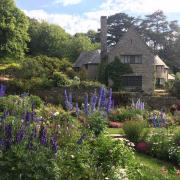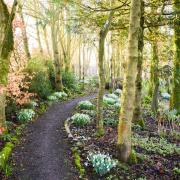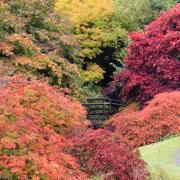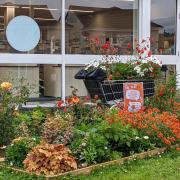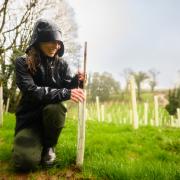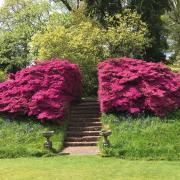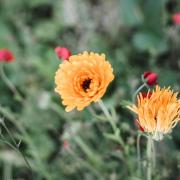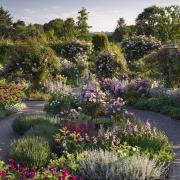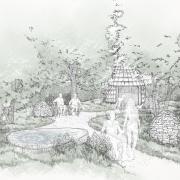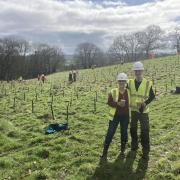August is the month where one particulary rare plant is in flower in a quiet nature reserve not far from Modbury. David Chapman paid a visit there to find out just more about the work being done at Andrew's Wood to encourage this beautiful purple ...
The damp and stony conditions in Andrew's Wood make an ideal habitat for one of Britain's rarest plants
Andrew's Wood is a nature reserve in South Devon a few miles from Modbury. When Devon Wildlife Trust (DWT) bought it in 1986 it was renamed by the previous owners in memory of their son, Andrew Walker. This quiet spot is nationally renowned for one very rare species of flower but last year I paid it a couple of visits to see if the wood was more than just a one-hit wonder.
In both my March and August visits the reserve was very wet underfoot, a fact explained by DWT's leaflet. The area was once known as Stanton Moor, Stanton meaning a stony place and the word 'moor' often referring to a marshy area. Today, although the reserve is called Andrew's Wood, and three-quarters of it is dominated by trees, a proportion is heathland and it's this, with its rare heath lobelia, that is arguably most significant in nature conservation terms.
Heathland is a relic of long-term grazing of the land, commonly formed by cutting down woodland and introducing grazing animals. Once, residents of the nearby hamlet of Stanton grazed their animals here. Over time the grazing of the land declined and the heathland began to revert to woodland.
Damp ground combined with heavy quartzite boulders has always made this a difficult place for cultivation. The history of the site, particularly the lack of ploughing and the absence of fertilisers and chemicals, has been critical in maintaining the unusual flowers that we see today. The single most significant species is the heath lobelia, a flower so rare that it is found at only a few other locations in Britain. The heathland is liberally scattered with these attractive purple flowers, so much so that they generate a landscape-scale colour, lending as much to the ground flora as any other species, and there are many other flowers here.
The heathland is still managed by grazing, but for animals to survive here they need to be hardy and accustomed to damp ground. DWT uses a small herd of four Exmoor ponies for this purpose: they graze the heath in the winter and are shifted to the nearby meadows in summer. Their grazing prevents scrub from invading areas where heathland flowers grow. Damp ground and ponies' hooves are a good recipe for bare patches of earth in which the seeds of heath lobelia can germinate.
Each year, in August, members of the DWT and volunteers count the number of heath lobelias in flower, a laborious but simple task because the flower is easy to recognise. Over recent years the number has increased, suggesting that the grazing regime works.
Recently the DWT has acquired 11.5 acres of adjacent improved grassland and it's hoped that some of these meadows will revert to damp heathland to encourage further colonisation by these lovely flowers.
The reserve isn't just about heath lobelia though; last August there was a wealth of flowers in the open sections of the reserve. Flowers attract insects and so there were butterflies aplenty - common species such as brimstone, comma and red admiral.
Some of the dampness underfoot is explained by the springs which emerge on some parts of the heathland, but despite my continued reference to the boggy conditions it can get surprisingly warm on this reserve. Most areas of heathland in Devon are open and exposed to the wind but this site is not - it's very well sheltered by the surrounding woodland. Should things heat up too much then this is an excellent place to escape. There is a footpath leading through the woodland with a boardwalk to take visitors through the wetter parts, and the path twists and turns around trees and over their roots, along ancient hedgebanks and across small streams.
Although my first impressions were of the damp conditions underfoot, the lasting impression was of a quiet, relaxing place - and were it not for the dampness this place would not be what it is today.
DAVID CHAPMAN
NOTE
If you wish to see heath lobelia, then do not delay. It usually begins flowering in July and continues until the beginning of September, so either pay a visit soon or make a note in your diary for next year.
ACCESS
This nature reserve is owned by the Devon Wildlife Trust, 01392 279244, www.devonwildlifetrust.org.
From the B3207 (Modbury to Halwell) take the turning at California Cross signed to Loddiswell. The reserve entrance is on the right, about 200m past the first crossroads. There is a small car park at OS grid ref SX 713519.
There is a well-marked nature trail through the reserve. Conditions underfoot can be very wet, so wear suitable footwear. The nearest refreshments are in California Cross.
JOIN THE LOBELIA COUNT
Join the annual lobelia count at the reserve on 9 August at 10am. For more information see our What's On/Countryside pages.
THROUGH THE SEASONS AT ANDREW'S WOOD
SPRING
Early spring will see much activity amongst resident birds in the woodland and before the end of spring migrants such as chiffchaff, willow warbler and blackcap will have returned. Ragged robin and marsh violet are amongst the less common species of flower here in spring. On the heathland look out for marsh orchids and heath spotted orchids in May and June. Grass snakes, which like damp conditions, can be found on the heath.
SUMMER
Flowers of the heath include: heath lobelia, yellow bartsia, tormentil, betony, knapweed, hemp agrimony, water mint, heather, bell heather, wild angelica, purple loosestrife and meadowsweet. In the woods look out for the flowers of broad-leaved helleborine and twayblade. Butterflies are plentiful: expect to see comma, red admiral, brimstone, purple hairstreak, marbled white and silver-washed fritillary. In the woodland you may find enchanter's nightshade, bilberry and a wide array of ferns. This is also a good area for dragonflies.
AUTUMN
The flowers of the heath will last well into autumn and the rank vegetation will hold many insects, including grasshoppers and crickets. You may spot late species of dragonfly such as the common darter. Woodcock return during autumn and spend the winter here.
WINTER
The ponies will be grazing on the heathland, though otherwise this will look a little lifeless, but in the woods a good range of birds will be feeding.
MORE INFORMATION:







